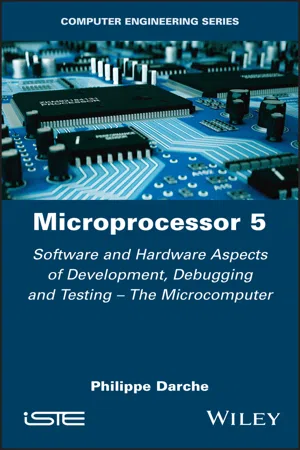
Microprocessor 5
Software and Hardware Aspects of Development, Debugging and Testing - The Microcomputer
- English
- ePUB (mobile friendly)
- Available on iOS & Android
Microprocessor 5
Software and Hardware Aspects of Development, Debugging and Testing - The Microcomputer
About this book
Since its commercialization in 1971, the microprocessor, a modern and integrated form of the central processing unit, has continuously broken records in terms of its integrated functions, computing power, low costs and energy saving status. Today, it is present in almost all electronic devices. Sound knowledge of its internal mechanisms and programming is essential for electronics and computer engineers to understand and master computer operations and advanced programming concepts. This book in five volumes focuses more particularly on the first two generations of microprocessors, those that handle 4- and 8- bit integers. Microprocessor 5 – the fifth and final volume of this series of books – first presents the hardware and software aspects of the development chain of a microprocessor-based digital system. Finally, to round up the series and offer a historical perspective, the architectures of the first microcomputers are detailed. A comprehensive approach is used, with examples drawn from current and past technologies that illustrate theoretical concepts, making them accessible.
Frequently asked questions
- Essential is ideal for learners and professionals who enjoy exploring a wide range of subjects. Access the Essential Library with 800,000+ trusted titles and best-sellers across business, personal growth, and the humanities. Includes unlimited reading time and Standard Read Aloud voice.
- Complete: Perfect for advanced learners and researchers needing full, unrestricted access. Unlock 1.4M+ books across hundreds of subjects, including academic and specialized titles. The Complete Plan also includes advanced features like Premium Read Aloud and Research Assistant.
Please note we cannot support devices running on iOS 13 and Android 7 or earlier. Learn more about using the app.
Information
PART 1
1
Development Chain
1.1. Layers of languages, stages of development and tools

1.1.1. Levels of languages
Table of contents
- Cover
- Table of Contents
- Title page
- Copyright
- Quotation
- Preface
- Introduction
- PART 1
- PART 2
- Conclusion of Volume 5
- Exercises
- Acronyms
- References
- Index
- End User License Agreement